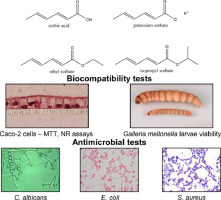当前位置:
X-MOL 学术
›
Eur. J. Pharm. Sci.
›
论文详情
Our official English website, www.x-mol.net, welcomes your
feedback! (Note: you will need to create a separate account there.)
Comparative biocompatibility and antimicrobial studies of sorbic acid derivates.
European Journal of Pharmaceutical Sciences ( IF 4.3 ) Pub Date : 2019-11-20 , DOI: 10.1016/j.ejps.2019.105162 Dániel Nemes 1 , Renátó Kovács 2 , Fruzsina Nagy 2 , Zoltán Tóth 2 , Pál Herczegh 3 , Anikó Borbás 3 , Viktor Kelemen 3 , Walter P Pfliegler 4 , István Rebenku 5 , Péter B Hajdu 5 , Pálma Fehér 1 , Zoltán Ujhelyi 1 , Ferenc Fenyvesi 1 , Judit Váradi 1 , Miklós Vecsernyés 1 , Ildikó Bácskay 1
European Journal of Pharmaceutical Sciences ( IF 4.3 ) Pub Date : 2019-11-20 , DOI: 10.1016/j.ejps.2019.105162 Dániel Nemes 1 , Renátó Kovács 2 , Fruzsina Nagy 2 , Zoltán Tóth 2 , Pál Herczegh 3 , Anikó Borbás 3 , Viktor Kelemen 3 , Walter P Pfliegler 4 , István Rebenku 5 , Péter B Hajdu 5 , Pálma Fehér 1 , Zoltán Ujhelyi 1 , Ferenc Fenyvesi 1 , Judit Váradi 1 , Miklós Vecsernyés 1 , Ildikó Bácskay 1
Affiliation

|
Nowadays, the sorbates are the third largest group of antimicrobial preservatives in food and pharmaceutical industries, following the parabens and benzoates whose safety is questioned by recent publications. A disadvantage of sorbates is their pH dependence, as their antimicrobial effect is greatly reduced in alkaline environment. The main, widely used sorbate derivatives are sorbic acid and potassium sorbate, no sorbic acid esters are involved in current industrial application. We aimed to test whether the esters of sorbic acid are capable to extend the antimicrobial spectrum of the original molecule while maintaining its advantageous biocompatibility profile. A comparative biocompatibility study of different derivatives (sorbic acid, potassium sorbate, isopropyl sorbate and ethyl sorbate) was carried out. In vitro cell viability assays of MTT (2-(4,5-dimethyl-2-thiazolyl)-3,5-diphenyl-2H-tetrazolium bromide), Neutral Red (3-amino-7-dimethylamino-2-methylphenazine hydrochloride) and flow cytometry with propidium iodide and annexin were performed on Caco-2 cells. In case of in vivo toxicity study, G. mellonella larvae were injected with different concentrations of the test compounds. Time-kill tests were executed on reference strains of C. albicans, E. coli, and S. aureus. According to the MTT-assay, the IC50 values were the following: ethyl sorbate, sorbic acid <0.045% w/w, isopropyl sorbate 0.32% w/w, potassium sorbate >0.75% w/w, while Neutral Red values were >0.75% w/w for the esters and potassium sorbate and 0.66% w/w for sorbic acid. Flow cytometry results indicated the higher cell damage in case of isopropyl sorbate. However, the cytotoxic results of isopropyl sorbate, in vivo toxicity study on G. mellonella larvae did not show significant mortality. It was found, that the antimicrobial properties of isopropyl sorbate were outstanding compared to sorbic acid and potassium sorbate. These results indicate, that the use of sorbate esters can be advantageous, hence, further toxicity studies are needed to prove their safety.
中文翻译:

山梨酸衍生物的比较生物相容性和抗菌研究。
如今,山梨酸酯是食品和制药行业中第三大抗菌防腐剂,仅次于对羟基苯甲酸酯和苯甲酸酯,其安全性受到最近出版物的质疑。山梨酸酯的缺点是它们的pH依赖性,因为它们的抗微生物作用在碱性环境中大大降低。广泛使用的主要山梨酸酯衍生物是山梨酸和山梨酸钾,在当前的工业应用中不涉及山梨酸酯。我们旨在测试山梨酸的酯是否能够扩展原始分子的抗菌谱,同时保持其有利的生物相容性。进行了不同衍生物(山梨酸,山梨酸钾,山梨酸异丙酯和山梨酸乙酯)的生物相容性比较研究。MTT(2-(4,5-二甲基-2-噻唑基)-3,5-二苯基-2H-溴化四唑),中性红(3-氨基-7-二甲基氨基-2-甲基吩嗪盐酸盐)的体外细胞活力测定在Caco-2细胞上进行碘化丙啶和膜联蛋白的流式细胞术。在体内毒性研究的情况下,将不同浓度的测试化合物注射到西瓜加勒斯特氏菌幼虫中。在白色念珠菌,大肠杆菌和金黄色葡萄球菌的参考菌株上进行了时间杀灭测试。根据MTT分析,IC50值如下:山梨酸乙酯,山梨酸<0.045%w / w,山梨酸异丙酯0.32%w / w,山梨酸钾> 0.75%w / w,而中性红值> 0.75对于酯和山梨酸钾为%w / w,对于山梨酸为0.66%w / w。流式细胞术结果表明在山梨酸异丙酯的情况下较高的细胞损伤。然而,由于山梨酸异丙酯的细胞毒性结果,对梅花线虫幼虫的体内毒性研究并未显示出明显的死亡率。已发现,与山梨酸和山梨酸钾相比,山梨酸异丙酯的抗菌性能优异。这些结果表明,使用山梨酸酯可能是有利的,因此,需要进一步的毒性研究以证明其安全性。
更新日期:2019-11-20
中文翻译:

山梨酸衍生物的比较生物相容性和抗菌研究。
如今,山梨酸酯是食品和制药行业中第三大抗菌防腐剂,仅次于对羟基苯甲酸酯和苯甲酸酯,其安全性受到最近出版物的质疑。山梨酸酯的缺点是它们的pH依赖性,因为它们的抗微生物作用在碱性环境中大大降低。广泛使用的主要山梨酸酯衍生物是山梨酸和山梨酸钾,在当前的工业应用中不涉及山梨酸酯。我们旨在测试山梨酸的酯是否能够扩展原始分子的抗菌谱,同时保持其有利的生物相容性。进行了不同衍生物(山梨酸,山梨酸钾,山梨酸异丙酯和山梨酸乙酯)的生物相容性比较研究。MTT(2-(4,5-二甲基-2-噻唑基)-3,5-二苯基-2H-溴化四唑),中性红(3-氨基-7-二甲基氨基-2-甲基吩嗪盐酸盐)的体外细胞活力测定在Caco-2细胞上进行碘化丙啶和膜联蛋白的流式细胞术。在体内毒性研究的情况下,将不同浓度的测试化合物注射到西瓜加勒斯特氏菌幼虫中。在白色念珠菌,大肠杆菌和金黄色葡萄球菌的参考菌株上进行了时间杀灭测试。根据MTT分析,IC50值如下:山梨酸乙酯,山梨酸<0.045%w / w,山梨酸异丙酯0.32%w / w,山梨酸钾> 0.75%w / w,而中性红值> 0.75对于酯和山梨酸钾为%w / w,对于山梨酸为0.66%w / w。流式细胞术结果表明在山梨酸异丙酯的情况下较高的细胞损伤。然而,由于山梨酸异丙酯的细胞毒性结果,对梅花线虫幼虫的体内毒性研究并未显示出明显的死亡率。已发现,与山梨酸和山梨酸钾相比,山梨酸异丙酯的抗菌性能优异。这些结果表明,使用山梨酸酯可能是有利的,因此,需要进一步的毒性研究以证明其安全性。











































 京公网安备 11010802027423号
京公网安备 11010802027423号